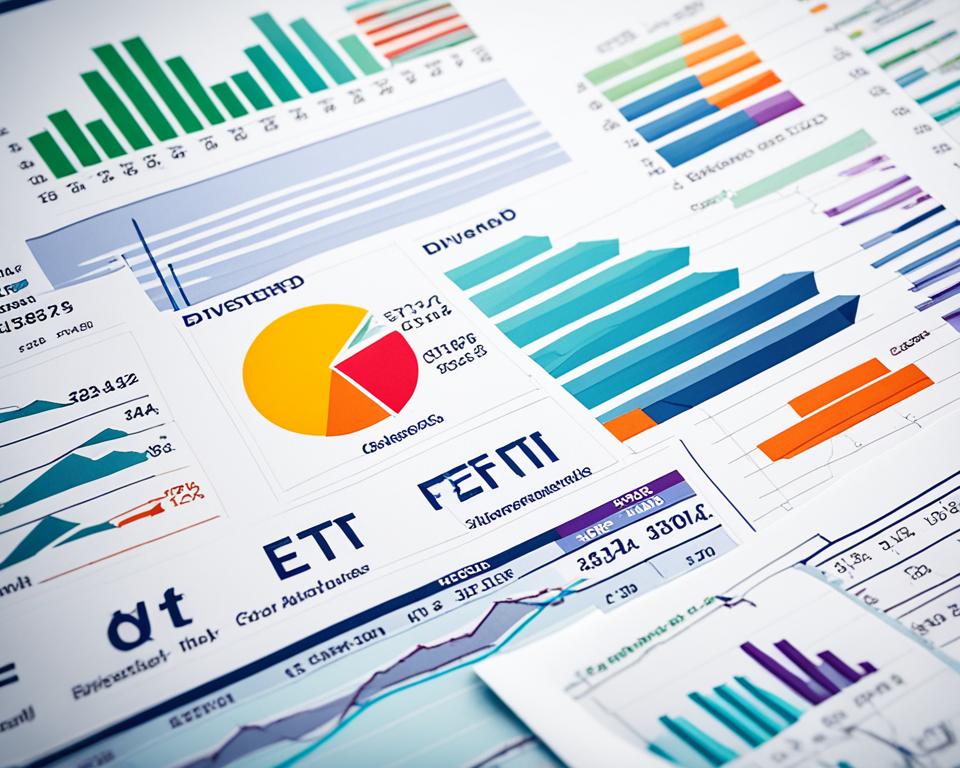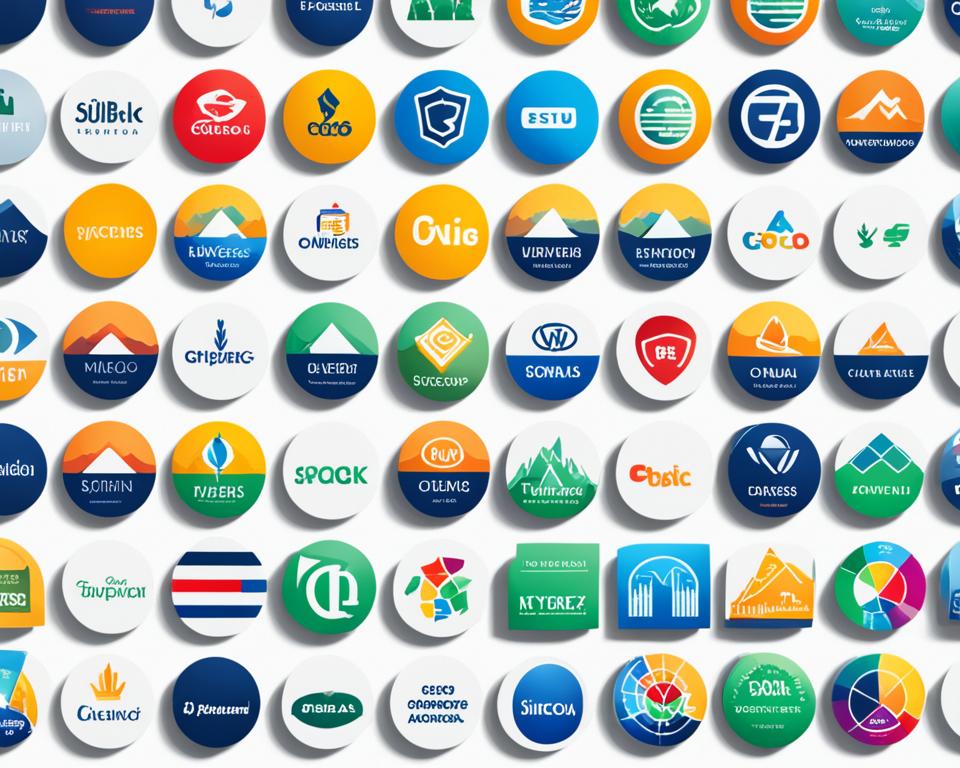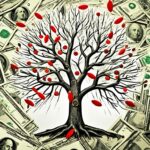With today’s uncertain market trends, you might be wondering, “are dividend ETFs worth it?” Investing in dividend ETFs offers a blend of regular income and the potential for asset growth, making them an attractive option for many investors. These funds have the advantage of distributing income to shareholders in the form of dividends, often on a quarterly basis. For those focused on building wealth over the long term, dividend ETF strategies are essential to consider, as they provide opportunities for reinvestment and, hence, a way to capitalize on the potency of compound interest.
Yet, with a surplus of funds saturating the market, how to choose dividend ETFs that align with your financial goals can seem daunting. Fear not—the key lies in selecting funds that demonstrate solid performance, a substantial annual yield, and manageable expense ratios. Such funds represent a convenient, straightforward avenue to owning a piece of companies known for their consistent dividend payouts. Still, as with any investment strategy, it’s recommended to assess your risk tolerance and return expectations before diving in.
Key Takeaways
- Dividend-paying ETFs could enhance cash flow and offer investment diversification.
- Evaluating dividend ETFs is crucial—consider annual yield, fund performance, and risk levels.
- Understanding your financial objectives can guide your choice in dividend ETF investments.
- Compound interest through reinvestment is a compelling reason to opt for dividend ETFs.
- Thorough research and planning are paramount when incorporating dividend ETFs into your portfolio.
Understanding Dividend ETFs and Their Appeal
The allure of having a financial portfolio that both grows over time and generates income cannot be overstated. Enter dividend Exchange-Traded Funds (ETFs), the investment vehicles that tap into the wealth-building power of dividend-yielding stocks. By pooling a collection of stocks that pay out dividends, these funds provide a level of income along with the potential for capital appreciation. Their rise in popularity is a testament to their perceived benefits, which resonate with a broad range of investors from the risk-averse to those more focused on steady returns.
Before we delve into the various benefits that these financial instruments offer, let’s break down the essentials of what constitutes a dividend ETF and why it might be a pivotal addition to your investment strategy.
What Are Dividend ETFs?
At its core, a dividend ETF is a type of fund that invests in a basket of dividend-paying stocks. These are stocks of companies with a history of distributing a portion of their earnings back to shareholders. By investing in a range of such companies, these funds aim to provide investors with a regular stream of income—inked with the performance and profits of those stocks. It’s a way to gain exposure to dividend payers across different sectors without the need to analyze and invest in each company individually.
Now, let’s consider how the principle of diversification is central to the value proposition of dividend ETFs.
The Benefits of Diversification Through ETFs
Diversification is a cornerstone of smart investing. By spreading investments across various financial instruments, sectors, or companies, you can reduce the risk of a single investment’s poor performance significantly impacting your portfolio. Dividend ETFs inherently offer this advantage by pooling multiple dividend stocks, thus mitigating the risks associated with investing in a single company. This diversification aspect is particularly appealing for those just dipping their toes in the investment world, as well as seasoned investors seeking a more stable income stream.
In the pursuit of portfolio diversification, it’s essential to weigh the performance of these funds. This consideration leads us to probe how dividend ETFs stack up against individual stocks in terms of returns.
Comparing Dividend ETF Performance to Individual Stocks
The performance of dividend ETFs can be as lucrative as that of individual stocks, with the added perks of reduced volatility and risk. Some of the best dividend ETFs in the market have been known to consistently deliver robust annual yields while maintaining a balanced approach to investment risk. Let’s take a closer look at the data, which illustrates these points.
| Dividend ETF | Annual Dividend Yield | 5-Year Return | Expense Ratio |
|---|---|---|---|
| Invesco S&P 500® High Dividend Low Volatility ETF | 3.5% | 12% | 0.3% |
| SPDR Portfolio S&P 500 High Dividend ETF | 4.2% | 13% | 0.35% |
| Vanguard Dividend Appreciation ETF (VIG) | 1.9% | 15% | 0.06% |
| Schwab US Dividend Equity ETF (SCHD) | 3.7% | 14% | 0.06% |
| WisdomTree US High Dividend Fund | 3.8% | 10% | 0.38% |
When analyzing dividend ETF performance, it’s important to take a long-term perspective. The performance during market dips and rallies provides insight into how these funds can stabilize your portfolio during turbulent times while still offering attractive returns. As such, metrics such as annual dividend yield, long-term returns, and expense ratios should be carefully considered—empowering you to discern the potential benefits of including dividend ETFs in your investment strategy.
Assessing the Benefits: Dividend ETF Advantages
When it comes to building a portfolio that can withstand market fluctuations while offering steady income, dividend ETFs emerge as a strong contender. Whether you’re an established investor or just starting, understanding the potential dividend ETF benefits is crucial to making well-informed investment decisions.
Income Generation from High-Dividend ETFs
One of the primary attractions of high-dividend ETFs is their ability to augment your income stream. Consider them a multifaceted tool in your financial toolkit—not only do they offer the prospect of income generation, but they also invite diversification into your portfolio. The convenience of investing in a wide array of dividend-yielding stocks through a single ETF has revolutionized how individuals approach income investing.
The numerous choices among high-dividend ETFs can cater to varying risk tolerances and investment preferences, making them a flexible option for income-focused portfolios.
However, it’s important to recognize that not all dividend ETFs are created equal. Some may present higher risks, particularly those with yields that appear too promising. Diligent research and a cautious eye for detail are necessary when evaluating which dividend ETFs will serve your financial aspirations best.
Reinvestment and the Compound Interest Effect
The power of compound interest is often hailed as one of the wonders of the investment world, and rightfully so. By reinvesting the dividends you receive from ETFs, even a modest initial investment can experience growth over the years. This is the snowball effect of compounding—earnings on your earnings that accumulate exponentially.
Choosing to reinvest your dividends rather than using them as immediate income can potentially turn your portfolio into a much heftier sum in the long run. This is particularly beneficial if you’re looking at the bigger picture and aiming for a more substantial nest egg down the road. As always, align these decisions with your financial timeline and aspirations to ensure that every step taken is a stride towards your ultimate monetary goals.
- Automated dividend reinvestments mean seizing every opportunity for portfolio growth.
- Compounding maximizes the effects of time on your investments, optimizing growth potential.
In essence, dividend ETFs offer a dual advantage: they can boost your present financial picture through income generation, and they can significantly contribute to your future wealth through the wonders of compound interest. By carefully selecting and managing these funds, you harness them not just for immediate gain, but also for the promise of a more prosperous tomorrow.
Dividend ETF vs Individual Stocks: Making the Right Choice for Your Portfolio
When it comes to shaping an investment strategy that aligns with your financial vision, the debate of dividend ETF vs individual stocks often surfaces. The choice you make can have significant implications for your portfolio’s performance, risk level, and the ease of management. Understanding the nuances of each option empowers you to invest with confidence and clarity.
Why Choose Dividend ETFs? Dividend ETFs offer a diversified approach to income generation, making them particularly appealing for novice investors or those with less time to manage their investments actively. By pooling a basket of dividend-yielding stocks, these funds reduce the impact of poor performance from any single company on your overall portfolio. Moreover, they can simplify the reinvestment process and provide easy access to a broader market segment.
The Case for Individual Stocks On the flip side, individual stocks can present the opportunity for higher potential returns, possibly yielding more significant income if well-chosen. However, they demand greater financial literacy to scrutinize financial statements and market trends. The rewards might be enticing, but the risks are proportionately higher, making them a better fit for those with the experience and appetite to manage such volatility.
To make a decision that best fits your investment strategy, consider these aspects:
- The level of diversification you aim to achieve.
- Your willingness to take on risk vs. the desire for steady returns.
- The time and resources you can dedicate to investment management.
- Your financial goals, whether short-term income or long-term capital growth.
While dividend ETFs provide a convenient, cost-effective method to scale investments, individual stocks allow for targeted investments in companies you have confidence in. It’s essential to consider the impact of fees associated with ETFs and potential trading costs for individual stocks to understand how these can eat into your projected earnings.
Reflecting on the dividend ETF vs individual stocks comparison, it’s evident that your choice hinges on the balance you wish to strike between convenience and control. Dividend ETFs can round out your portfolio with their inherent diversified nature, while individual stocks can sharpen its focus, provided you are equipped with the requisite investment acumen. As you chart your investment journey, ensure that your portfolio complements your financial roadmap and empowers you to achieve your monetary aspirations.
Remember, there is no one-size-fits-all answer in investing. Your unique financial landscape and investment knowledge should drive your decision on navigating the course between dividend ETFs and individual stocks.
High-Dividend ETFs: Can You Rely on Them for Retirement?
Contemplating the landscape of retirement income can lead one to consider various investment vehicles. Among these, high-dividend ETFs stand out as a compelling option due to their potential to generate a steady flow of income. When investment planning for retirement, these funds could serve as a stronghold in your financial arsenal. Embarking on that journey, let’s explore the viability of depending on high-dividend ETFs for your golden years.
Are Dividend ETFs a Viable Retirement Plan?
Sculpting a retirement plan around dividend ETFs can be akin to building a financial foundation on bedrock rather than sand. With their propensity for offering stable income distributions, these ETFs are often favored by retirees and those nearing retirement. They act as a financial buttress, propping up your nest egg with periodic payments that could cover regular expenses or be reinvested to further enhance your portfolio’s growth.
However, the journey doesn’t end with the mere selection of dividend ETFs. It evolves into a nuanced strategy involving the management of investments that can weather the undulating nature of market conditions. To this end, the famed 4% rule surfaces as a guideline, suggesting that retirees may withdraw up to 4% of their savings annually for a comfortable retirement without depleting their core assets prematurely.
Strategizing for a Sustainable Income Stream in Retirement
As you unfurl the blueprints of your retirement, considering a holistic strategy weaves a safety net that can cradle your financial well-being. The tapestry of retirement income is not monochromatic; it involves hues of Social Security benefits, pension funds, 401(k)s, IRAs, and personal savings. High-dividend ETFs are the threads that add strength and resilience, potentially filling any gaps in your income tapestry.
Realistic spending projections, under the meticulous eye of investment planning, can transform high-dividend ETFs into a robust stream of retirement income. Yet, it’s important not to be lulled into complacency by attractive yields alone. Keep abreast of the ever-evolving financial landscape, ensuring your retirement strategy adapts and thrives. Perhaps the best course lies in diligent consultation with a financial advisor, whose expertise can tailor a portfolio of high-dividend ETFs to your specific retirement vision, solidifying it as an integral part of your overarching investment planning.
Such consideration and action embody the prudent approach to retirement—one that fosters peace of mind, knowing that your latter years are cushioned by the thoughtful selection of high-dividend ETFs.
Remember, high-dividend ETFs, when integrated within a comprehensive investment planning framework, can bolster your retirement income, providing a reliable source of funds that can support you through your non-working years.
How Dividend Yields Influence ETF Attractiveness
As you explore the world of investing, the term dividend yield often crops up, particularly when discussing dividend ETF strategies. A solid understanding of this concept can significantly influence your decision-making process and impact the attractiveness of potential investments.
Interpreting Dividend Yields
Dividend yield is a financial ratio that shows how much a company pays out in dividends each year relative to its stock price. When it comes to dividend ETFs, this yield is a snapshot of potential income returns against your investment cost. A higher dividend yield may seem appealing at first glance because it suggests a generous return on your investment. However, it’s crucial to perform thorough dividend ETF strategies and risk assessment to ensure that high yields are a sign of strength and not a red flag.
Understanding Risks Associated with High-Dividend Yields
At times, a high dividend yield might be indicative of a stock price that has fallen significantly, suggesting company distress that could endanger future dividend payouts. Hence, while high yields can capture an investor’s attention, they also warrant a deeper look into the company’s long-term stability and growth prospects. Use dividend yield as a starting point but lean on comprehensive risk assessment methods to decide whether an ETF fits within your investment horizon and risk tolerance.
Remember, the key to successful income investing is finding the sweet spot where attractive yields align with solid company fundamentals and growth prospects. This begins with understanding the dividend yield not as a standalone beacon but as one factor within a larger investment context. So, as you evaluate various options, always consider how a fund’s yield measures up against its peers, and recognize the role it plays in indicating both potential returns and risks.
High dividends can signal promising income potential, but without proper risk assessment, they may lead investors into unstable territory.
Inside the Best Dividend ETFs: A Look at Prominent Funds
For those in search of steady income and potential growth, dividend ETFs stand out as a sound investment option. Within the pantheon of these investment vehicles, certain funds are often heralded for their impressive dividend ETF performance. Identifying the attributes that contribute to the stature of top-performing funds can be the cornerstone of a strategic investment decision.
Below, we delve deep into the characteristics of best dividend ETFs, which have engraved their names on the leaderboard due to a mix of strong dividend yields, judicious expense management, and substantial assets under management (AUM). These elements work in concert to elevate the status of a dividend ETF, ensuring that its performance is not a flash in the pan but rather a consistent showcase of stability and resilience.
Analyzing Top Performing Dividend ETFs and Their Traits
The hallmark of a top-performing fund is not just found in its current yield but also in the strategic assembly of its portfolio. Funds such as the Vanguard Dividend Appreciation ETF (VIG) and Schwab US Dividend Equity ETF (SCHD) have gained recognition in the investing community for their low expense ratios, indicating that more of your investment is working for you rather than being consumed by fees.
Meanwhile, a robust AUM reflects investor confidence and fund liquidity—critical factors when assessing the resilience of a fund in different market conditions. Strong financial health, coupled with a history of consistent dividend payments, has been the bedrock of these best dividend ETFs.
A Snapshot of Market-Leading Dividend ETFs and Their Yields
Focusing on some of the best funds in the market today provides us with a clear picture of what real performance looks like in the realm of dividend ETFs. Here is a table to help put things into perspective:
| ETF | Annual Dividend Yield | Expense Ratio | AUM |
|---|---|---|---|
| Vanguard Dividend Appreciation ETF (VIG) | 1.9% | 0.06% | $79.0 billion |
| Schwab US Dividend Equity ETF (SCHD) | 3.7% | 0.06% | $48.0 billion |
| WisdomTree US High Dividend Fund | 3.8% | 0.38% | Data not available |
| SPDR S&P Dividend ETF (SDY) | 2.8% | 0.35% | $20.0 billion |
| iShares Select Dividend ETF (DVY) | 4.0% | 0.38% | $18.0 billion |
To refine your selection and pinpoint the funds that resonate with your investment philosophy, it’s wise to consider the interplay of the yield, expense ratio, and AUM, which together, present a composite view of an ETF’s attractiveness.
With this information at your fingertips, you’re better positioned to select the best dividend ETFs that not only promise returns but deliver performance through an effectively managed and diversified portfolio.
Investing in Dividend ETFs: What to Look For
Determining how to choose dividend ETFs that align with your investment goals involves a careful analysis of various critical factors. As you evaluate your options, pay attention to three primary considerations that could significantly impact your portfolio’s performance and your satisfaction as an investor: expense ratio, assets under management (AUM), and dividend yield.
Crucial Factors When Selecting the Right Dividend ETF
The process of selecting the right dividend ETF involves several layers of assessment. While the allure of a high dividend yield is strong, it shouldn’t be your sole deciding factor. Instead, gauge the expense ratio, explore the assets under management, and compare the dividend yield across various funds to ensure a well-rounded evaluation.
Considering Expense Ratios, AUM, and Yield in ETF Selection
When delving into the vast sea of dividend ETFs, remember that an expense ratio is, in essence, the cost of owning the ETF. The lower the expense ratio, the less you’ll pay to the fund manager, which means more of your investment stays vested in earning potential gains. But don’t just stop there. Assets under management matter, too. A larger AUM may indicate more stability and liquidity, which could be critical during market fluctuations. Finally, the dividend yield gives you a glimpse into the returns you could expect in relation to your investment cost. Balancing all three considerations should lead you to dividend ETFs that suit your approach to income investing.
A practical way to visualize and understand the importance of these factors is by examining a table comparing several dividend ETFs. So, let’s examine a comparative presentation to aid in your decision-making process.
| ETF Name | Expense Ratio | Assets Under Management | Dividend Yield |
|---|---|---|---|
| Vanguard High Dividend Yield ETF (VYM) | 0.06% | $59.0 billion | 3.3% |
| SPDR S&P Dividend ETF (SDY) | 0.35% | $20.0 billion | 2.8% |
| Schwab U.S. Dividend Equity ETF (SCHD) | 0.06% | $48.0 billion | 3.7% |
| iShares Select Dividend ETF (DVY) | 0.38% | $18.0 billion | 4.0% |
| WisdomTree U.S. High Dividend Fund | 0.38% | Data not available | 3.8% |
By taking into account these essential factors, you’re poised to choose dividend ETFs that not only meet your expectations for income but also align with your financial aspirations and investment horizon. Remember, while the search for the perfect dividend ETF might seem complex, focusing on these crucial considerations could streamline the process and lead you toward a rewarding investment experience.
Constructing a Dividend ETF Strategy for Income Investors
As an income investor, you’re likely seeking financially savvy methods to enhance cash flow through dependable streams like dividend ETF strategies. Dividend-paying Exchange-Traded Funds (ETFs) provide a balanced approach to income investing, and constructing a strategy built around them requires a calculated blend of understanding your income needs, as well as a planned investment horizon.
A well-devised dividend ETF strategy can potentially transform your portfolio into a powerful income-generating tool.
When you combine growth and income objectives, you pave the way for a dynamic investment strategy. ETFs that focus on sectors known for steady dividends offer a reliable income, while funds that lean towards growth can amplify your portfolio’s value over time. Additionally, income from higher-yielding ETFs can be reinvested, propelling your earnings through the implications of compound interest—a concept that can’t be overlooked by savvy investors.
Yet, your strategy must not overlook the relevance of tax implications on income distributions. The tax treatment of dividends varies based on the type of account you hold them in, such as an Individual Retirement Account (IRA) vs. a taxable brokerage account. Efficient tax planning can help in preserving your returns, nudging you closer to your financial goals.
Consider a diversified approach to minimize risk while maintaining an investment mix that suits your risk tolerance. Here’s a comparative look at some top dividend ETFs:
| ETF | Yield | Expense Ratio | Assets Under Management |
|---|---|---|---|
| Vanguard High Dividend Yield ETF (VYM) | 3.3% | 0.06% | $59.0 billion |
| SPDR S&P Dividend ETF (SDY) | 2.8% | 0.35% | $20.0 billion |
| Schwab U.S. Dividend Equity ETF (SCHD) | 3.7% | 0.06% | $48.0 billion |
| iShares Select Dividend ETF (DVY) | 4.0% | 0.38% | $18.0 billion |
| WisdomTree U.S. High Dividend Fund | 3.8% | 0.38% | Data not available |
While some may prefer harnessing growth through reinvestment, others might find value in ETF strategies that employ covered calls to generate additional income streams. Deciding between these strategic playbooks hinges on your investment timeline and the immediate versus future financial needs.
Your quest for income investing should be grounded in due diligence. By diligently weighing factors like yield, risk, and tax efficiency, you can deftly navigate the world of dividend ETFs toward a fruitful financial future.
The Role of Dividends in Total Portfolio Returns
The tenacity of dividends in bolstering total portfolio returns is no secret to seasoned investors. As you glance through the annals of the S&P 500, dividends stand out for their substantial contribution, reinforcing the importance of a strategic dividend ETF strategy in your investment repertoire. Recognizing dividends’ impact on portfolio performance is more than a historical lesson; it’s a guideline for future financial prosperity.
Dividends’ Historical Contribution to S&P 500 Returns
Dividends have woven a significant thread through the fabric of investment history, serving as a key component of total portfolio returns. Since the 1930s, dividends have accounted for an estimated 40 percent of the S&P 500’s total returns. This figure carries the weight of economic ups and downs, affirming the role of dividends as a steadfast source of investor returns. As such, a savvy investment strategy that includes dividends can help solidify your S&P 500 holdings, making it more than just an equity growth play.
The Impact of Reinvesting Dividends on Overall Portfolio Growth
The elegance of reinvested dividends lies in their ability to exponentially amplify the growth of your portfolio. Since 1960, reinvested dividends have represented a staggering 69 percent of the S&P 500’s total returns. By incorporating a dividend ETF strategy with a focus on reinvestment, your gains are set to potentially compound, escalating the growth trajectory of your investments. In essence, reinvested dividends are the silent engines that propel portfolio growth, giving you an edge in the pursuit of a more resilient financial future.
FAQ
What Are Dividend ETFs?
Dividend ETFs are investment funds that track indexes comprising dividend-paying stocks. They provide a diversified portfolio and access to a collection of stocks that regularly distribute dividends, all within a single investment vehicle.
The Benefits of Diversification Through ETFs?
Diversification through ETFs helps spread out investment risk across various assets, reducing the impact of any single stock’s poor performance on your overall portfolio. By investing in multiple dividend-paying companies, your investment is not overly reliant on the success or failure of a single entity. This is especially appealing to those who seek to mitigate risk while enjoying a steady stream of dividend income.
Comparing Dividend ETF Performance to Individual Stocks?
Dividend ETFs offer diversified exposure to a range of dividend-paying stocks, which can provide a more stable income stream and potentially lower risk than investing in individual stocks. While individual stocks can offer higher rewards, they also come with higher risks and require more in-depth market knowledge. Dividend ETFs can perform competitively with individual stocks and often come with lower fees.
Income Generation from High-Dividend ETFs?
High-dividend ETFs focus on generating income by investing in a portfolio of stocks known for paying higher dividends. They can be a cornerstone for investors, particularly those seeking a regular income stream to fund their living expenses, without requiring them to trade regularly.
Reinvestment and the Compound Interest Effect?
Reinvesting dividends is a powerful way to harness the power of compound interest. By reinvesting the dividends you receive, you purchase more shares in the ETF, which can then generate their own dividends, potentially leading to exponential growth of your investment over time.
Are Dividend ETFs a Viable Retirement Plan?
Dividend ETFs can be a component of a retirement plan, providing a steady stream of income. However, they should be balanced with other retirement income sources like Social Security, pensions, and retirement accounts. They offer a level of diversification and possible risk reduction, but it’s crucial to have a comprehensive and balanced approach to retirement planning.
Strategizing for a Sustainable Income Stream in Retirement?
To create a sustainable income stream in retirement from dividend ETFs, one should consider factors like the 4% rule for withdrawals, the consistency of dividend payments, the need for principal growth, and the impact of inflation. Reinforcing dividend ETFs with other income-producing investments and considering a mix of growth and income-focused ETFs could also be part of a successful strategy.
Interpreting Dividend Yields?
Dividend yield is a financial ratio that indicates how much a company pays out in dividends each year relative to its stock price. It is a key indicator of an investment’s potential income, but it’s important to balance yield with other considerations such as the stability and growth prospects of the dividend-paying companies within the ETF.
Understanding Risks Associated with High-Dividend Yields?
While high-dividend yields can be attractive, they may also come with higher risks. Sometimes a high yield can indicate a potential cut in dividends or reflect a declining stock price. It is essential to assess the fundamentals of the companies in the ETF’s portfolio to ensure that the dividends are sustainable.
Analyzing Top Performing Dividend ETFs and Their Traits?
Top-performing dividend ETFs often have a track record of consistent dividend payments and are composed of financially stable companies. Attributes to look for include low expense ratios, strong assets under management (AUM), and a focus on businesses that have a history of increasing their dividends.
A Snapshot of Market-Leading Dividend ETFs and Their Yields?
Market-leading dividend ETFs like Vanguard Dividend Appreciation ETF (VIG) and Schwab US Dividend Equity ETF (SCHD) have been recognized for their solid performance, focusing on companies with a steady dividend history. The current yield can be assessed along with historical performance and fund size to make an informed choice.
Crucial Factors When Selecting the Right Dividend ETF?
When selecting the right dividend ETF, you should consider factors such as expense ratios, dividend yield, and assets under management. These elements affect the overall cost of the investment, the potential income it can generate, and the liquidity of the ETF.
Considering Expense Ratios, AUM, and Yield in ETF Selection?
Expense ratios impact the cost of owning an ETF — lower ratios are generally better for investors. AUM gives you an idea of the fund’s size and liquidity, and the dividend yield indicates how much income you could potentially earn relative to the price of the ETF. Balancing these factors will help you choose an ETF that aligns with your goals.
Dividends’ Historical Contribution to S&P 500 Returns?
Historically, dividends have been a significant source of total returns for S&P 500 investments, accounting for about 40% of returns since the 1930s. When dividends are reinvested, this contribution can be even more substantial, emphasizing the importance of dividends in long-term investment growth.
The Impact of Reinvesting Dividends on Overall Portfolio Growth?
Reinvesting dividends has a profound impact on portfolio growth — when reinvested, dividends can represent a large portion of the total return on an investment, especially over longer periods. This is an important consideration for compounding wealth and enhancing the growth of one’s investment portfolio.












